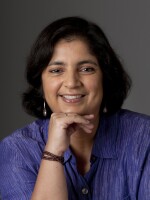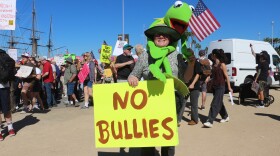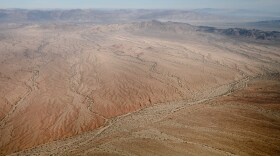India and Pakistan have fought a few "hot" wars over the past 60 years, and there's always an underlying tension in the relationship. The Wagah border crossing along the Grand Trunk Road is the only place where the Indian and Pakistani militaries meet face to face -- every day.
This is the place where those tensions are ritualized, and as the daughter of parents who lived through the traumatic creation of India and Pakistan, I needed to see it for myself.
It is a mere accident of history -- or perhaps cartographic negligence -- that the border between India and Pakistan is where it is. If the mapmaker had made a different decision, maybe things would have been different for my family.
What if the mapmaker had drawn a line a few miles farther west than he did? Would my mother's family home have stayed in India, instead of becoming part of Pakistan? If he'd drawn it a few miles further east, my dad's birthplace might now be in Pakistan instead of India. Maybe the trajectory of my family would have been totally different.
In 1947, India and Pakistan were created from the same cloth as British India was partitioned between Muslims and Hindus. Millions were on the move, Muslims heading west to the Muslim state of Pakistan and Hindus moving east to predominantly Hindu India.
My mother was an 8-year-old Hindu child who moved to Delhi, India, just ahead of independence day. Countless Muslims made the reverse trip. Later the route would become a bloodbath of carnage and sectarian violence, and the state of Punjab, the birthplace of both my parents, would be ripped in two.
Wagah marks the spot in Punjab where you can walk across the border between the two countries.
There is a theatrical display surrounding the daily flag lowering ceremony as the border is closed for the night. It ends in a handshake between both sides, but not before some very over the top strutting and shouting, snorting and glaring.
As I write this, I am on the Pakistani side of the divide. Segregated bleachers fill up with folks who have paid 10 rupees (about 13 cents) to watch the spectacle.
You can feel the pulsing rhythms of the entertainment on the Indian side, their bleachers full to the brim. The music is loud and the crowd is in full chant. It's difficult to see much of what's happening on the "other" side, but the Pakistani side is clearly not to be outdone.
Macho Pakistani flag-wavers whip their crescent moon flags in a frenzy accompanied by a drummer. The crowd is egged on with a patriotic chant. The loudspeakers blare patriotic songs extolling "peace for all," reminding the crowd "never forget, Pakistan is ours."
This ruckus is the preamble to the ceremony. Soldiers from the Pakistani Rangers, in a precision formation of high kicks and foot stomping, march to face their Indian rivals across the gate that divides them.
They wear splendid dress uniforms, the traditional salwar kameez. Their black turbans sport a wide peacock-like plume -- these guys are clearly on display.
The Indians perform a similar ritual. The respective flags are lowered and folded, and with a handshake, perhaps a glimpse of a smile, the pomp and circumstance is over for the evening. The satisfied throngs in both countries head home.

So what's the point of this Wagah crossing hoopla?
It's a bit of a proxy of course, the Indian and Pakistani militaries meeting face to face. The ceremony is ritual, too, which is important in this part of the world.
Entertainment for the masses can't be underestimated. But I like to think that it's a demonstration of optimism. A mapmaker determined the divide that's been in place for three generations, but for a few hours every day that line is erased.
At this border crossing, people can move between the countries. Traders are engaged in back-and-forth commerce as flamboyantly painted trucks ride the Grand Trunk Road.
The route was once continuous through this great subcontinent. And, for a couple of hours a day at least, it is once again open all the way from the easternmost shores of India to the frontier provinces of Pakistan.
Madhulika Sikka is executive producer of NPR's Morning Edition. She was born in India and grew up in London, and lives in the U.S.
Copyright 2022 NPR. To see more, visit https://www.npr.org. 9(MDAzMjM2NDYzMDEyMzc1Njk5NjAxNzY3OQ001))







